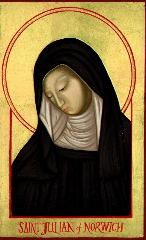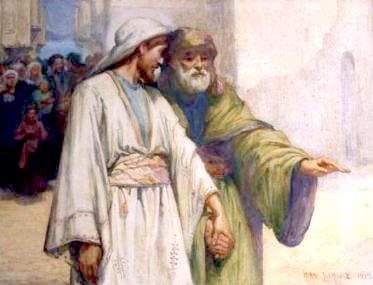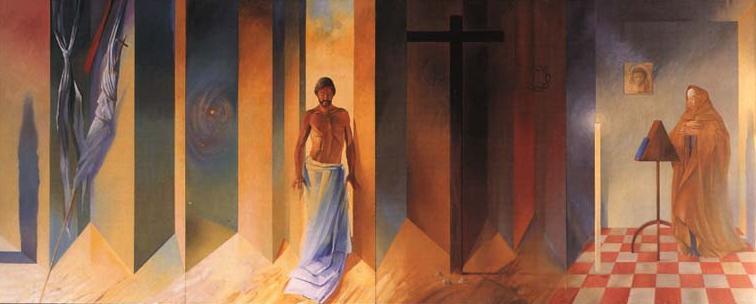Sacred Conversation: Contemplative Art (original) (raw)
JULIAN OF NORWICH, HER SHOWING OF LOVE AND ITS CONTEXTS �1997-2024 JULIA BOLTON HOLLOWAY || JULIAN OF NORWICH || SHOWING OF LOVE || ST BIRGITTA OF SWEDEN || BIBLE AND WOMEN || EQUALLY IN GOD'S IMAGE || MIRROR OF SAINTS || BENEDICTINISM|| THE CLOISTER || ITS SCRIPTORIUM || AMHERST MANUSCRIPT || HEAVEN WINDOW || CATALOGUE (HANDCRAFTS, BOOKS ) || BOOK REVIEWS || BIBLIOGRAPHY || Simone Martini, Museo Horne, Florence � Editrice Giusti de Becocci, SRL, Italy.
SACRED CONVERSATION:
CONTEMPLATIVE ART

t was many years ago, in San Francisco, when Chinese treasures from Taiwan were on exhibition, that I heard aged grandmothers explaining to small children how to read a scroll painting. 'Put yourself into the picture,' they were saying. 'Become the man on the bridge, experience the mountains about you, hear the water, feel the sunlight. The person in the painting is there for you.' Such a different way to read a picture! We have frames around ours. We are not in them, but outside. Perhaps that is a mistake. A Jesuit priest, Father Thomas J. Steele, explained of the art of the New Mexican and Coloradan Penitentes that its lack of perspective is desirable, that perspective came in with the Renaissance's use of gunpowder and is about marksmanship. We distance ourselves from what we are about to shoot. But a child needs to be gathered up in our arms and we become the Mother of God. Father Steele also speaks of aged Spanish women seeing Penitente art in museum and complaining that there is not one candle lit before them. We need, like Alice, to step into the Looking Glass, becoming ourselves children, lacking perspective, for such is the Kingdom of Heaven. And we need a blaze of candles before the shimmering gold leaf. We need prayer in our paintings.
In the Hospital of St John at Bruges we find Hans Memling's great triptych, in one wing the Vision, the Showing, the Revelation, of St John the Apocalypse. It has always been here in this room. We too stand before it, outside of time, gazing through its Heavenwindow, its Soul City, entering into God's eternity, becoming ourselves God-centred, God mirroring, God's Book and ours in our hands, likewise mirroring each other's, in a sacred conversation of rainbow song.
 Hans Memling, St John writing Revelation, St John's Hospital, Bruges. Reproduced by permission of Memlingmuseum Stedelijke Musea, Brugge, Belgium
Hans Memling, St John writing Revelation, St John's Hospital, Bruges. Reproduced by permission of Memlingmuseum Stedelijke Musea, Brugge, Belgium
St Birgitta of Sweden , Julian of Norwich's contemporary, made countless pilgrimages, dying in Rome following her last one to Jerusalem in her seventieth year. Her great friend, Francesca Papazzuri, gave the room in which Birgitta had written her Revelationes and had her visions, to be a small church and commissioned for it a painting that would celebrate all these. In the Florentine Archives is her letter written to Lapa Acciaiuoli, the sister of the Florentine Chancellor of Naples, Nicolo` Acciaiuoli, who had built the abbey of Certosa in remorse for his sins. In that letter Francesca Papazzuri says what she wants to have in the painting. It is to be a triptych, small, for prayer, at an altar. But it is to be crowded with scenes and saints, so many in fact, that the painter rebelled and only filled half the bill. And in this letter we see that often it was women who told artists what to paint. And that they did so, fashioning these paintings according to their own devotions, carried out through pilgrimages, through prayers, through sacred conversations. They are about bodies and souls.
Francesca Papazzuri wants the centre panel to have Birgitta as an aged pilgrim in the Cave at Bethlehem, envisioning Mary at the Nativity , worshipping her just-born Child, laid on the ground, greeting him with the words, 'Welcome, my God and my King. ' There is also to be a Crucifixion with Mary and John and Mary Magdalen at its feet. And a host of saints, among them St Nicholas of Bari , for Birgitta and Francesca had pilgrimaged together to Bari to visit his tomb and shrine.
We have the letter, written from Rome to Florence, commissioning the painting. We have the painting, now in Philadelphia, just as the letter describes, except excluding much of the plethora of saints. Once it would have been in St Birgitta's Roman Church. And there Margery Kempe, who made all Birgitta's pilgrimages herself in turn, would have seen it.
In Francesca Papazzuri's letter we glimpse Julian of Norwich 's sacred conversation, with the new born Child, greeted as the Maker who would be born of her who is made, and with the dying Christ on the Cross .
At Upton House in England is a painting by Pieter Breughal of the Death of the Virgin. It is the scene Julian describes as she lies, as all think, dying. It is the scene of Catherine of Siena's dying, too. The painting is all in grisaille. At fire smoulders to the left, before it a snoring, sleeping servant girl, ugly, oblivious. Perhaps she is ourselves, sleeping our lives away, denying like Peter, James and John at Gethsemani, and in Jerusalem, the Kingdom of Christ. To the right is the Virgin in bed, a heavenly light all about her, while she gazes upon the cross propped up on pillows at her feet. One startles into the realisation that this Crucifix is that of her own dead Son upon which she gazes with such love. All about her too cluster her followers, the apostles and the women, their faces mirroring the joy that is in the Virgin's, while Peter, looking like a Rabbi, places a candle in her hand.

Myra Luxmore, 'Christ Healing the Blind Man', 1912. Photograph, Revd. Kenneth Clinch, Chaplain General, Community of the Holy Family
Myra Luxmore in 1912 painted Christ healing the Blind Man. She also painted the Annunciation. Her family were friends of Gerard Manley Hopkins. I found her paintings in my convent, one in a junk room, another in a dusty attic. She had traveled to Palestine as it then was called and studied it intensely. Every detail of the garments comes from observing the exquisite embroidery still carried on there. Every scene is shot through with the knowledge of the topography of the Sea of Galilee, of the architecture of Cana. She had been a friend, too, of my Mother Foundress, Agnes Mason, C.H.F. Mother Agnes' brother, Canon Arthur Mason, had given her the 1912 painting and for years it had hung in St Mary's Chapel, built out of a stable, by Mother Agnes, in memory of St Teresa's similar Foundation.
Not only are the paintings filled with detailed knowledge of the modern Holy Land and people as they are there in our time; they also take you into Christ's presence, granting you sight from blindness, in a shimmer of delicate colour, or into that of Gabriel appearing to Mary one Palestinian morn beneath cypress trees. They are of real flesh and blood people, of our day, touched, as Julian and Dionysius, Pseudo-Dionysius, would say, by the Spirit. They are about ourselves and of our 'even-Christians'. Julian, in the Short Text, resents the official 'paintings of Crucifixes ', the oppressive Byzantine officialising of religious art. She penetrates beyond that clutter to Christ as Man. Dante ends his_Commedia_ by saying that Christ appears 'as if painted in our image'. God and Man, in that image, mirror each other, God is in us.
Massaccio painted the Trinity, Julian's Trinity, in the Florentine Dominican church of Santa Maria Novella, to which St Catherine of Siena had come to be tried by the Inquisition. Yes, he played with perspective. We look up at the looming figure of God the Father, his face filled with sorrow as he holds up the heavy cross upon which is his Son, between them the Dove of the Holy Ghost. And we become, as women and men, like the two figures on either side, Mary and John, who gesticulate, showing us the scene. They are holding a sacred conversation with God and with us, mediating as diplomats between differences. Beneath them in prayer are the donors, again mirrors of ourselves as we are now. A cadaver at their feet, again myself as I shall be. Unless we pray, all we shall have is death. But because we 'one' ourselves in Christ's dying, perhaps, we can steal, like the Good Thief, a place at his side at the heavenly banquet.
When I enter Santa Maria Novella and pray there, before going on to Mass at St Mark's English Church the other side of the Arno, it is often to find the Massaccio bathed in rainbow lights, from the stained glass windows conspiring with Christus Sol. Then, as I exit the great west doors, which signify death and Doomsday, there, in another fresco, I see Birgitta of Sweden, the widowed mother of eight children, in the cave in Bethlehem, at the Nativity, witnessing the Virgin's worshiping of her just-born Child. Birgitta had journeyed to Bethelehem the last year of her life, her seventieth year, knowing she was dying. God conspires with us against death.

The illustration is taken from the painting of Julian's Showings in St Gabriel's Chapel, Community of All Hallows, Ditchingham, Near Bungay, Suffolk. Painted by the Australian artist, Alan Oldfield, it was earlier exhibited in Norwich Cathedral. It is photographed by Sister Pamela, C.A.H. Reproduced by kind permission of the Community of All Hallows, and the Friends of Julian, Norwich, England.
An Australian artist, Alan Oldfield, has been painting vast canvasses on Julian. They were hung in Norwich Cathedral and one heard comments from aged vergers about how extraordinary it was that these huge paintings about a Norwich girl should have come all the way from 'Down Under'.
But the seventh-century Ruthwell Cross in Scotland, beyond Hadrian's Wall, shows the scene of the woman washing Christ's feet with her tears and drying them with her hair because the Gospels record Christ's words that what she has done will be known about to the ends of the earth.
One of these canvases by Alan Oldfield now hangs in Ditchingham's St Gabriel's Chapel. It takes up an entire wall of a large room. 'Thou hast set my feet in a large room '. Alone, in silence, one can be there in a sacred conversation that speaks volumes, for hours and hours on end. Christ enters, in Aaron's and Mary's blue robes, about which Jerome wrote in a letter to Fabiola, which Julian gives to the Lord, who is God and who is the Pope as High Priest, in her Book, and which Mother Agnes Mason, C.H.F., from her brother, Arthur Mason's study of the Priesthood, gave to her Sisters. The candle, which Birgitta saw in her vision of the Nativity, which is Julian's Profession candle, is beside her. Alone, and in silence, but not alone, for there are Christ and Julian, in silence, but not in silence, for there one clearly hears and sees Julian's and Christ's words, written in red in one manuscript, there one is in intense prayer. It is the Shekinah, the presence of God, wrought by a woman's Book of Showings.
The Dominican Monastery of San Marco was truly blessed by the presence as a worker guest within it, Beato Fra Angelico whose own monastery is nestled beneath the citadel of Fiesole . He painted for the friars' cells scenes for contemplation, sacred conversations, where a Dominican nun or monk kneel in prayer and wonder at the feet of the Annunciation, the Crucifixion.
One walks past these cells so filled with prayer in silence and joy. And notes that Fra Angelico's Eve and Mary are the same blonde Florentine girl who hears the message EVA/AVE, undoing time's sin, as do we all if we choose, to become ourselves Christ bearers, Christophers and Marys, with God's presence in us, in whose image we are made.
I yearn to do a Julian Website booklet on the Rosary, illustrating it with Fra Angelicos of the Joyful, Sorrowful, and Glorious Mysteries that others may pray as once had Angelico's brother monks at San Marco and to link these words with that Internet booklet in this fathering, and mothering, this Portfolio of Julian's Library of Contemplation.
Prayer is best as Praise, even as Jubilation. At times, silence in best, at others song, even dance. Augustine's conversion involved a singing child, 'Tolle, lege, tolle, lege', and also his vision of Christ was as a child playing with the sea. Luca della Robbia fashioned a Cantoria, a Choir Balcony, for the Duomo, giving such joyous playful chanting children, such as we must be to enter Heaven's Kingdom, and around the figures inscribed the words they sing, from Psalm 150.

LAVDATE EVM IN CIMBALIS BENE SONANTIBUS: LAVDATE EVM IN CIMBALIS IUBILANTIONIS.
For further panels from this Cantoria and from the other by Donatello see Heavenwindow, nine all told, and for the story of these century-old photographs, see I Fratelli Alinari: Florentine Photographers .
'LAVDATE D OMINV M IN SANC TIS EIVS; LAVD ATE EV M IN FIR MAMENTO VIRTVTIS EIVS; L AVDATE EVM S ECVNDV M MVLTITVDINEM MAGNITVDIN IS EIVS
LAVDATE EVM IN SONO TVBAE; LAVDATE EVM IN PSALTERIO ET CVTHARA: LAVDATE EVM IN TIMPANO
ET CHORO; L AVDATE EVM IN CORDIS ET ORGANO; LAVD ATE EVM IN CIMBALIS BENE SONANTIBVS: LAVDATE EV M IN CIMBALIS IUBILA NTIONIS; OMN IS SPIRITVS LAVDET DOMIN VM'.
It is a work of art, now, alas, in a cold museum, but which needs rather to be in sacred space and filled with song and psalm and psaltery. All making a joyful noise to the Lord, all generations, young and old, women and men, together. Pentecost .
These Fratelli Alinari photographs were taken over a hundred years ago, bought by my Mother Foundress,Agnes Mason , C.H.F., in Florence, where she conceived the Comunity of the Holy Family as a Teaching Order in the Church of England, drawing it closer to the Church of Rome.

Simone Martini (-1344). 'Madonna con il Bambino e Piet�' (Diptych). Museo Horne, Florence, Italy; � Editrice Giusti de Becocci S.R.L., Florence, Italy.
Simone Martini painted a diptych of the Madonna and Child and the dead Christ as Pieta`, the one of things new born, the other of things dying. Against shimmering Byzantine gold leaf, the Madonna garbed as an Empress, the artist paints their living flesh, Christ's red-gold hair (David being 'Adamiu ' in Hebrew, 'ruddy '), combining both spirituality and flesh and blood, both a Byzantine icon and a Renaissance painting. Christ's nail-pierced and wounded hands rest on the frame, come out of the frame and into our lives. These are the ' hands that made and fashioned us', the Hebrew for hand being yod, the smallest letter of the Hebrew alphabet, yet the letter that begins God's name and those of Jesus, Jerusalem and Julian. Julian speaks for her 'even-Christian', made and fashioned by God in his image. Julian speaks for smallness, as the whole earth, as the entire cosmos that God holds in his hand, as like a nail-head or a hazel nut in her own hand.


In contemplating the Simone Martini, which is painted for prayer, one is in the presence of Julian's two images, of the Mother and Child, of Conception and Birth, and of the Crucifixion, of the Dying of Christ. Julian surrealistically imposes these images upon each other. Simone Martini gives them as two leaves of a Diptych, to be read from left to right like a book, but like a book also to be closed, where Death becomes Life, where time can run backwards. 'Diptych' once meant the two hinged tablets of wax, written upon with a stylus. Our names as 'Sons' and as 'Daughters ' of 'Adam' (Christ calling himself our Brother, Son of ' Our Father' , 'Ben-Adam '), 'Adam' in Hebrew meaning red, our names in rubricating blood are written upon Christ's waxen hands in those wounds made by the iron nails. Yet he forgives us that writing and gives us back that blood we share, to share with him that bitter-sweet chalice, and to drink with him in blessing and thanksgiving to God. 'Blessed art thou, Lord, King of the Universe, who hast given us this fruit of the vine and the work of human hands'
Think of God become Man, the Word become Flesh, and dwelling amidst us, here and now, in the Mass. Say these simple words at Communion, 'Wheat and Grapes, Bread and Wine, Flesh and Blood, Death and Life '.

Let Julian place a hazel nut in your hand.
JULIAN OF NORWICH, HER SHOWING OF LOVE AND ITS CONTEXTS �1997-2024 JULIA BOLTON HOLLOWAY || JULIAN OF NORWICH || SHOWING OF LOVE || ST BIRGITTA OF SWEDEN || BIBLE AND WOMEN || EQUALLY IN GOD'S IMAGE || MIRROR OF SAINTS || BENEDICTINISM|| THE CLOISTER || ITS SCRIPTORIUM || AMHERST MANUSCRIPT || HEAVEN WINDOW || CATALOGUE (HANDCRAFTS, BOOKS ) || BOOK REVIEWS || BIBLIOGRAPHY ||
